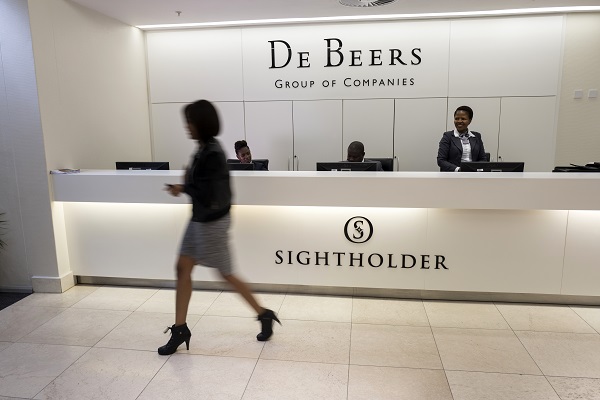|
|
De Beers Turns to Tech as Layoffs Loom
Aug 3, 2020 11:12 AM
By Avi Krawitz
|
|
|

RAPAPORT... De Beers is no stranger to changing strategy. Throughout its 130-plus-year history, the company has often adjusted its approach, sometimes with just a few tweaks, and on other occasions with radical consequences for the diamond market.
Its next incarnation implements a bit of both as the company aims to emerge from the Covid-19 crisis a sleeker, more flexible and more tech-savvy organization that it hopes will increase the efficiency of the diamond supply chain. The overarching approach is to utilize data and technology to drive efficiencies, explained Stephen Lussier, executive vice president for consumer and brands at De Beers, in an interview with Rapaport News following the publication of the group’s interim earnings report on Thursday. (See Challenges Persist as De Beers Sees Red.)
The strategy was already in the works before the coronavirus outbreak, but the crisis accelerated its implementation, Lussier noted.

Already in early March, the company announced an overhaul of its sight system as it opened applications for the next sightholder contract period beginning in January 2021. De Beers said it would split sightholders into three categories, since manufacturers, rough dealers and retailers who rank among its customers each have different rough-diamond requirements to fit their respective business models.
While the contract application process has been put on hold as the industry copes with the virus, the principles stated in that initial teaser remain: De Beers is aiming to provide a more customized product, and it is relying on technology to achieve that goal.
Technology will enable De Beers to sort and package its production quicker and more effectively supply rough according to the sightholder’s required polished outcome, Lussier added. That will require investing in innovations such as robotics, and some technologies that haven’t yet been invented, to create a structure through which diamonds can move much more quickly from its mining and assortment operations to sightholders, and into the retail markets, he explained.
“Time is money, so that frees up capital and will inject profitability not only for ourselves, but also for our sightholders,” the executive stressed.
An integrated approach
The focus on technology extends to De Beers’ mining operations, where it can drive efficiency at a time when mines are getting older, deeper and more expensive to run, Lussier noted. Tech will also enable the company to meet its goal to be carbon-neutral across all its mining operations by the end of the decade, he added.
But perhaps the most important element of the approach will be its use of technology and data analysis to improve the interaction between its businesses at various stages of the supply chain — mining, rough sales and retail.
“The core to the vision we have of the future is how we integrate data across the upstream, midstream and downstream [in a way] that allows us to manage the entire business with far greater insight into what’s happening in the market,” Lussier explained.
The company hasn’t publicized a budget for the program, but Lussier expects the investment will change the way in which De Beers runs its business on a daily basis.
Potential layoffs
The onset of Covid-19 not only forced De Beers to implement the strategy more quickly, but it also compelled it to do so in a more cost-effective way, given the impact the coronavirus has had on the jewelry market and diamond-cutting centers, Lussier said.
Last week, De Beers reported a net loss of $214 million in the first half of 2020, as rough sales slumped 56% to $1 billion due to the impact of the coronavirus. Most of that revenue was generated pre-pandemic in January and February. Second-quarter sales fell 93% to an estimated $94 million, according to Rapaport calculations.
The company is considering its options to reduce costs. This week it will begin a consultation process with employees across all its business units that will likely result in layoffs, Lussier confirmed.
“We haven’t any targets or detailed plans but we recognize that in addressing our cost base, given the impact of Covid-19 on the business plan, there will likely be reductions in people at various operations around the world,” Lussier said. “We need to focus on cost containment so we can invest in our initiatives in 2021, 2022 and onwards.”
Short-term outlook
As rough demand is expected to remain depressed in the coming months, tightening costs is a necessary step. De Beers expects “significant challenges” in the short term, with ongoing travel restrictions in southern Africa and sustained risk of further spread of Covid-19 in India’s cutting centers, the company stressed in its interim report.
The miner continues to hold sights outside of its Botswana selling base, “being much more flexible in where, when and how we sell,” Lussier added. And if demand increases while travel restrictions remain in place, he is confident sightholders will get the supply they need.
“We’ve always been [at] somewhat [of an] advantage because of the consistency of our rough boxes,” he observed. “Perhaps more than other [miners], our clients are willing to buy sight unseen because they have confidence in what’s inside [their boxes].”
Lussier, who also serves as the chairman of De Beers’ Forevermark brand, is expecting some improvement in the rough market in the second half of the year, largely because consumers are coming back, he observed. Chinese demand is leading the recovery, but there are also encouraging signs among US independents, particularly around bridal and other higher-value goods.
However, the company proceeds with caution and is as focused on containing costs as it is on ensuring it is ready to capitalize on the uptick when a sustainable recovery takes shape.
“[The results from the first half] were not unexpected when we looked at the impact of Covid-19, as we’ve all seen what’s happened in the luxury-goods world and with our sights,” he said. “But I think the economic impact has just accelerated the need for us to push forward with creating the De Beers we already felt we needed to be successful in the future.”
Main image: De Beers’ sales headquarters in Gaborone, Botswana. Inset: Stephen Lussier. (De Beers)
|
|
|
|
|
|
|
|
|
|
Tags:
Avi Krawitz, Botswana, Coronavirus, COVID-19, De Beers, diamonds, Forevermark, Jewelry, mining, Stephen Lussier
|
|
|
|
|
|
|
|
|
|
|

|
|